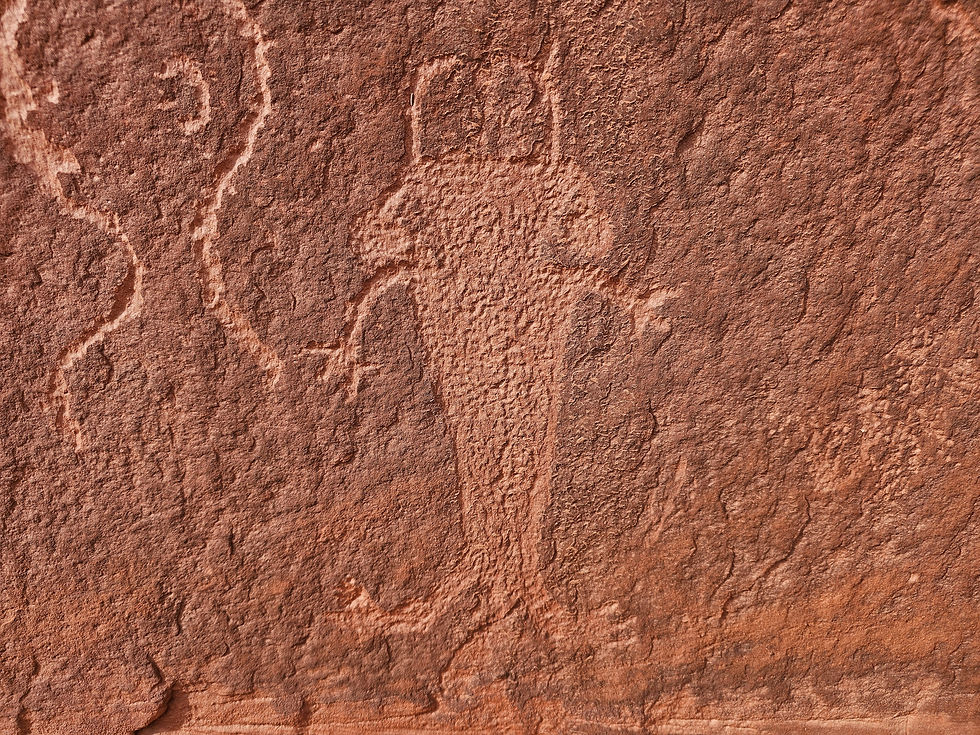The Golden Cathedral: An Iconic Treasure in Grand Staircase-Escalante
- Dan Wagner
- 1 day ago
- 4 min read
Tucked away in the depths of Lower Neon Canyon, Golden Cathedral stands as a masterpiece of nature’s artistry, a place where time, water, and stone have conspired to create something truly divine. Enclosed by towering Navajo sandstone walls that rise like the vaulted ceilings of an ancient temple, the breathtaking alcove is a testament to the quiet power of the desert. Golden Cathedral is defined by its skylights—two massive holes in the rock ceiling, carved over millennia by the persistent flow of water. Standing beneath the skylights, one feels humbled by the vastness of something timeless. It is a place of solitude and wonder, a hidden sanctuary in the wild heart of Grand Staircase-Escalante, where nature’s quiet grandeur speaks louder than words.


Trailhead elevation 5,610'
Water from several crossings of the Escalante River
Don't miss the massive petroglyph panel after the final river crossing
Hiking to The Golden Cathedral
After returning from an overnighter to Cosmic Ashtray, I wash off with my Geyser portable shower behind the truck, cook up some lunch, relax for a bit, and then set out again—this time for an overnighter out to the postcard worthy Golden Cathedral.
The drive down Hole-in-the-Rock Road is mellow enough, but Egypt Road quickly proves to be a different beast altogether. Rutted, uneven, and wild, it makes me grateful for every inch of clearance on my truck. I arrive at the parking area and find that I'm on my own tonight, thankfully. I repack my bag, drink half a gallon of water, and make my way to the trailhead.
From the edge of Egypt Bench, the world spills wide open—an endless panorama of slickrock domes, rolling sand dunes, sculpted canyons, and the distant silhouettes of the Henry Mountains and Factory Butte. It feels like standing on the rim of another world.

I descend a sandy series of switchbacks, the path marked by cairns, before reaching an expansive slope of slickrock that plunges into the valley below.

At the bottom, a weathered sign marks my entrance into Glen Canyon National Recreation Area, and I continue on, winding along a sun-scorched trail of alternating sand and stone that shadows the South Fork of Fence Canyon.

Around the 2.2-mile mark, the descent into Fence Canyon begins in earnest. By now, blue skies have quickly turned overcast and I worry that a storm is approaching. I detour briefly to a plateau that overlooks the confluence of Fence and its sister to the east, the South Fork. From above, a lush cluster of tamarisk glows green against the rust-colored world—a rare splash of color in this otherwise scorched landscape.

After a moment to take in the view, I push forward. The trail carves a steep descent along the canyon wall, switchbacking until I find myself walking among the tamarisk. As I snake through the thick grove, I can’t help but wonder about the ancient footsteps that once echoed here—what lives unfolded in this canyon, what stories have been lost to time?

Soon, near the 3.3-mile mark, the Escalante River comes into view. With no recent beta, I eye the current warily. I reach its edge, swap into my Tevas, and step in. It starts shin-deep, but by midstream, the water is clawing at my waist, the sandy riverbed shifting beneath me as the current tries to sweep me away. I push through and pull myself onto the opposite bank to dry ground. I think to myself, that was stupid. The current was strong and I got lucky. Over the next half mile, I cross the Escalante four more times—some crossings shallow, others chest-deep, some with soft sand underfoot, others a bed of slick, grapefruit-sized boulders.


After the fifth crossing, Fence Canyon opens up. About 100 yards later, a fork in the trail appears.

I follow the left path, curious, and soon spot a small alcove carved into the canyon wall.

While the alcove shows no signs of ancient use, just beyond it stretches an enormous petroglyph panel—eighty feet long, twenty feet high. Native carvings mix with old cowboy graffiti from the 1800s. I linger here, tracing the faded lines and pondering the hands that etched them.



Eventually, the left fork reconnects with the main trail. Before long, I veer left into Lower Neon Canyon. The terrain here tightens. Its narrow walls drip with desert varnish, and the canyon floor bursts with green: tamarisk, cottonwoods, desert flora swaying in the breeze. The path curves and twists like a living thing.

Half a mile in, I scramble over a boulder jam—and there it is. My first glimpse of Golden Cathedral. I round the bend, and suddenly I'm beneath it, staring up at the twin skylights carved high into the ceiling. It's spellbinding.

I walk around the cathedral's emerald pool, gaining new perspectives with each step. An hour before sunset, the canyon is bathed in the sun’s final, golden breath—its warm glow igniting the eastern wall in a blaze of amber and fire. The silence is absolute, profound, as if the world itself has paused to witness this moment. I stand alone in the stillness, utterly enveloped by beauty, and for a fleeting instant, I am in heaven.

Moss clings to the canyon walls like velvet, and the whole space hums with stillness, as if the land itself is holding its breath.

I pitch my tent beneath a grove of cottonwoods, make dinner, and soak in the solitude. As dusk settles, I watch a half dozen bats dance above the pool and a lone bird call from somewhere high above. Another day in paradise fades into night.

Morning comes gently. A light rain patters on the tent, coaxing me awake. I lie still, listening, waiting. The rain passes, the songbird returns, and time seems to stop once again. When I finally pack up and climb out of the canyon, the ascent is tough, but my spirit is light. I reach the trailhead around 11:00 AM, tired but exhilarated. Another perfect chapter in Escalante comes to a close. I shower at the trailhead once more and then head off for the next adventure—Peek-A-Boo and Spooky Slot Canyons.
_edited.png)











































































Comments